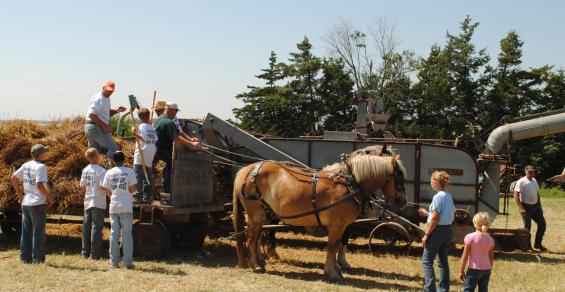Then and Now: The Nebraska Tractor Test Laboratory director shares his thoughts on what equipment might look like decades from now.
Farmers, young and young at heart, love old tractors. But what will horsepower in the field look like a decade from now, or a half-century from now?
No one knows for sure, but if anyone has a vision of the future of tractors, it would be Nebraska Tractor Test Laboratory director Roger Hoy.
Related: Early tractors could use multiple fuels
To give us contrast, we looked back to the Jan. 19, 1915, issue of Nebraska Farmer — a time period when “real” horses offered much of the horsepower for farmers, but tractors were starting to become more accepted.
On Page 49 in that issue, there are listings for Belgian and Percheron draft horses for sale, but we also noticed a tiny ad in the bottom-left corner of Page 42 that promoted the two-cylinder Huber 20-40 tractor, and how one man and one Huber tractor could do the work of six men and 12 horses.
We can’t attest to the accuracy of this claim, but in 1929, the Nebraska Tractor Test Laboratory tested the upgraded version, the Huber Master Four 20-40, which was introduced in 1925 and used a four-cylinder Hinkley engine.
Huber tractors, manufactured in Marion, Ohio, are just a few examples from the hundreds of tractors that have been tested at NTTL since the lab was established in 1920. A John Deere Waterloo Boy was the first tractor successfully tested there.
Electric is coming
The Huber, like so many tractors of the era, could run on gasoline or kerosene. But since 1977, NTTL hasn’t tested any tractors other than diesel-powered. That era of diesel dominance is probably not coming to an end, but there could be competition from another power source — electricity — to move tractors through the field and down the road.
With more and more research from companies such as Monarch and Soltrac going into the development of electric-powered tractors, it is probably just a matter of time.
“The Nebraska Tractor Test Law only requires testing on 100 PTO horsepower tractors and above,” Hoy says. “We did an unofficial test with a couple of Soltrac tractors a few years ago, but our equipment was far too large” for the lower-horsepower tractors that were brought in.
Right now, Soltrac is marketing 25-, 40- and 70-hp tractors. Monarch has the MK-V, which the company says has a 70-hp peak and 10 hours of run time before it needs recharging. This is an issue of development among the electric tractors, Hoy says.
“As far as electric tractors go, most everything is there except the batteries,” he says. “I am assuming that an electric tractor will become generally accepted when a few conditions are met.”
OLD HORSEPOWER: An ad that appeared in the Jan. 13, 1915, issue of Nebraska Farmer promotes the idea of a Huber tractor and operator doing the same work as six men and 12 horses. In the same issue, there are a lot of ads for real horsepower — draft horses.
Cost would be the first condition — cost of purchase and cost of operations. Those would need to come close to that of a diesel-powered conventional tractor, Hoy says. Battery capacity is the second one.
“Battery capacity needs to allow for 10-12 hours of field work, and battery recharge time needs to be comparable to refueling time,” he says.
As tractors get lighter, the battery capacity and technology are developing. “Battery technology will develop enough to increase power density and reduce weight enough to get to the right range,” Hoy says. “Rapid recharging is emerging now and will only get better with time, so I don’t think that will be an obstacle.”
So, the day is probably near when NTTL will test its first electric large-horsepower tractors.
A step further
Automation, in general, is going to affect things in the field, Hoy believes. “The Green Revolution of the 20th century was about first mechanizing agriculture, and then about achieving additional reduced human costs by increasing equipment size and scale,” he explains. “The paradigm was, ‘Go large so a single human operator can do more.'”
As autonomous machinery comes to the field with no operator, this paradigm is broken, and the reasons for being large cease to exist, Hoy suggests.
“I can imagine one human supervisor managing 10, 20 or 50 smaller automated machines,” he says. “As we think about how to get more food out of the same land to feed the rising world population, automation may allow some other improvements to occur that change farming practices.”
NEW HORSEPOWER: While nearly all tractors in the field are diesel-powered, the day may come when even large tractors are electric-powered.
Hoy asks, “If through automation, we can go to the plant scientists and agronomists and allow them the possibility to treat individual plants in a field optimally rather than the same treatment on whole fields or sections of fields, what would be the yield increase?”
Being a smaller operator may change how plants are seeded. “If we are small, perhaps planting crops in rows changes to planting complementary plants in non-rows,” Hoy suggests. “One objection is always how to harvest multiple plants at the same time, but combines are already sorting machines, so this could be simply one more sorting task to perform.”
The concept could be taken even further, considering smaller feed animal lots located in close proximity to farmland so the animal-waste products could replace some of the applied nitrogen today, he adds.
Hoy doesn’t have a crystal ball, and he acknowledges that his thoughts are exercises in looking forward, but with his insights into the development of machines on the farm, don’t bet against him.
Learn more about NTTL at tractortestlab.unl.edu.




